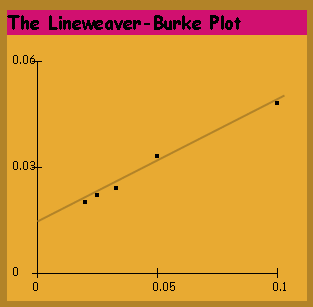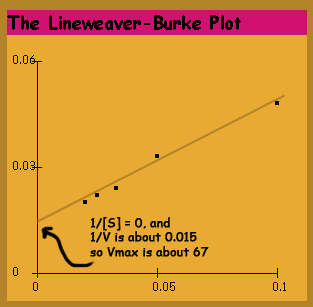Let's graph
So let's graph this line. Remember, we're still assuming that we are experimenters and we don't know the values of Vmax and Km. All we know is that at certain values of [S], we got certain values of V (i.e., we put out some amount of M&M packages and got some rate of goop production. We can start with our datatable and take the inverse of everything, then plot those inverses on a graph:
| trial | 1 | 2 | 3 | 4 | 5 |
|---|---|---|---|---|---|
| [S] | 10 | 20 | 30 | 40 | 50 |
| V | 21 | 30 | 41 | 45 | 49 |
| trial | 1 | 2 | 3 | 4 | 5 |
|---|---|---|---|---|---|
| 1/[S] | |||||
| 1/V |
Vmax: Km:
Now since we know that the graph SHOULD look like a straight line, we can draw a straight line through the data:

| If you turn on javascript, this becomes a rollover |
Generally you should use some kind of regression here, but we'll just eyeball it, to speed up the process a bit.
And now the $64,000 question: how does this graph help us find Vmax? We could approach the question from one of two angles -- both of which give the same answer:
Graphical: We know that Vmax happens only when substrate is essentially infinite. If [S] is infinite, then what is 1/[S]? . So, look to see what 1/V is when 1/[S] is zero.
That value is 1/Vmax.
Algebraic: The equation for a line is y - intercept + slope*x. Since our line has the equation
1/V = 1/Vmax + Km/Vmax * 1/[S]
the intercept is 1/Vmax.
According to either line of reasoning, the value of Vmax is the reciprocal of whatever the y-intercept is.
Copyright University of Maryland, 2007
You may link to this site for educational purposes.
Please do not copy without permission
requests/questions/feedback email: mathbench@umd.edu